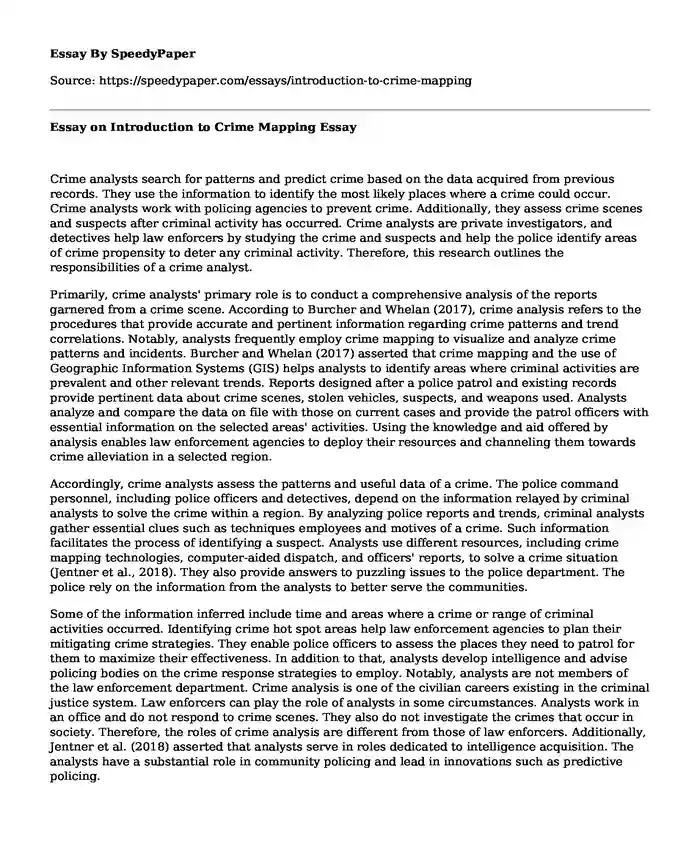
| Type of paper: | Essay |
| Categories: | Law Criminal law Criminal justice |
| Pages: | 3 |
| Wordcount: | 717 words |
Crime analysts search for patterns and predict crime based on the data acquired from previous records. They use the information to identify the most likely places where a crime could occur. Crime analysts work with policing agencies to prevent crime. Additionally, they assess crime scenes and suspects after criminal activity has occurred. Crime analysts are private investigators, and detectives help law enforcers by studying the crime and suspects and help the police identify areas of crime propensity to deter any criminal activity. Therefore, this research outlines the responsibilities of a crime analyst.
Primarily, crime analysts' primary role is to conduct a comprehensive analysis of the reports garnered from a crime scene. According to Burcher and Whelan (2017), crime analysis refers to the procedures that provide accurate and pertinent information regarding crime patterns and trend correlations. Notably, analysts frequently employ crime mapping to visualize and analyze crime patterns and incidents. Burcher and Whelan (2017) asserted that crime mapping and the use of Geographic Information Systems (GIS) helps analysts to identify areas where criminal activities are prevalent and other relevant trends. Reports designed after a police patrol and existing records provide pertinent data about crime scenes, stolen vehicles, suspects, and weapons used. Analysts analyze and compare the data on file with those on current cases and provide the patrol officers with essential information on the selected areas' activities. Using the knowledge and aid offered by analysis enables law enforcement agencies to deploy their resources and channeling them towards crime alleviation in a selected region.
Accordingly, crime analysts assess the patterns and useful data of a crime. The police command personnel, including police officers and detectives, depend on the information relayed by criminal analysts to solve the crime within a region. By analyzing police reports and trends, criminal analysts gather essential clues such as techniques employees and motives of a crime. Such information facilitates the process of identifying a suspect. Analysts use different resources, including crime mapping technologies, computer-aided dispatch, and officers' reports, to solve a crime situation (Jentner et al., 2018). They also provide answers to puzzling issues to the police department. The police rely on the information from the analysts to better serve the communities.
Some of the information inferred include time and areas where a crime or range of criminal activities occurred. Identifying crime hot spot areas help law enforcement agencies to plan their mitigating crime strategies. They enable police officers to assess the places they need to patrol for them to maximize their effectiveness. In addition to that, analysts develop intelligence and advise policing bodies on the crime response strategies to employ. Notably, analysts are not members of the law enforcement department. Crime analysis is one of the civilian careers existing in the criminal justice system. Law enforcers can play the role of analysts in some circumstances. Analysts work in an office and do not respond to crime scenes. They also do not investigate the crimes that occur in society. Therefore, the roles of crime analysis are different from those of law enforcers. Additionally, Jentner et al. (2018) asserted that analysts serve in roles dedicated to intelligence acquisition. The analysts have a substantial role in community policing and lead in innovations such as predictive policing.
In conclusion, criminal analysts have significant roles in enhancing law and order in society. A crime analyst's role is to assess the patterns and trends of crime and advise the police officers on where to channel their resources. Crime analysts enable investigators and police officers to conduct their law enforcement activities effectively. They do not visit crime scenes. Instead, analysts evaluate existing police reports and pictures, among other evidence gathered from a crime scene, and advise the law enforcers on the next and most appropriate course of action. Although crime analysts are not a part of the law enforcement agencies, their contribution has helped in crime investigation.
References
Burcher, M., & Whelan, C. (2017). Social network analysis as a tool for criminal intelligence: Understanding its potential from the perspectives of intelligence analysts. Trends in Organized Crime, 21(3), 278–294. https://doi.org/10.1007/s12117-017-9313-8
Jentner, W., Sacha, D., Stoffel, F., Ellis, G., Zhang, L., & Keim, D. A. (2018). Making machine intelligence less scary for criminal analysts: reflections on designing a visual comparative case analysis tool. The Visual Computer, 34(9), 1225–1241. https://doi.org/10.1007/s00371-018-1483-0
Cite this page
Essay on Introduction to Crime Mapping. (2024, Jan 03). Retrieved from https://speedypaper.net/essays/introduction-to-crime-mapping
Request Removal
If you are the original author of this essay and no longer wish to have it published on the SpeedyPaper website, please click below to request its removal:
- The Case of Freddie Gray - Police Brutality Paper Sample
- Essay Sample on Sex Exploitation in the UK
- Analyzing "Due Process" and "Street Justice" In Ethical Issues Essay
- Criminal Law Foundations Evaluation in Our Free Essay
- Annotated Bibliography Example on Decoding Stop-and-Frisk: Analyzing Policies, Impacts, and Reform Perspectives
- Free Essay Sample: Causes and Consequences of Human Trafficking
- Inmate Suicide and Overcrowding: Challenges and Solutions in the U.S. Criminal Justice System
Popular categories




